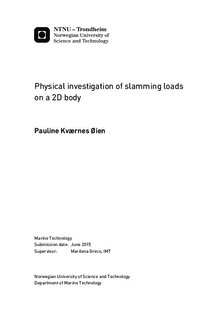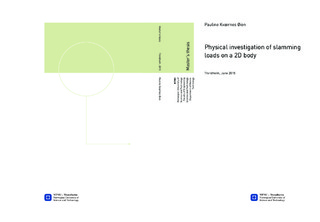| dc.description.abstract | In this thesis a physical investigation of the slamming loads on a two-dimensional body is performed. It includes an experimental analysis of a drop test performed at MARINTEK's laboratories on a wedge shaped section in two-dimensional flow conditions. Due to confidentiality, the experiment will only be referred to as 'the MARINTEK experiment'. From a former analysis of the experimental results at MARINTEK, deviations between measurements and theoretically predicted impact loads were found. The need for a further investigation of the involved features was announced. A search for an explanation for these deviations is the motivation behind this thesis. This task is demanding, and experienced researchers have already made an attempt of explaining the observed behaviour.
A rigid wedge with a mass of 170 kg and a deadrise angle of ${10^ \circ }$ was dropped from three drop heights: 0.1, 0.25 and 0.5 m. Pressure, force and position were measured. The accelerometers were not set up during the experiments so the acceleration data files proved to be empty. Velocity derived from position measurements was used instead. The pressure sensors are mounted on the force panel.
All data from the tests have been available and analysed in Matlab. Features of the measured pressure and force for different drop heights were analysed. The observed features are compared to theoretical predictions. Measurement techniques and applicability limits of theoretical models were studied as a background for the discussion of deviations between theory and measurements. Other slamming experiments were also studied to be aware of common challenges and for comparison with results from the MARINTEK experiment.
Differences between measured data and theoretically predicted results were found. Wagner's theory (1932) was used for comparison. Spatial distribution of maximum pressures and pressure coefficients showed values differing from the prediction by Wagner. A discrepancy between integrated pressure and force measurements over the panel was found. This occurred for the lowest drop height only. It was found that the lowest drop height showed the largest deviations from theoretical predictions in most of the analyses made.
Various effects that can affect the results were assessed. The change in velocity was investigated, but it was concluded that the small changes in velocity are not capable of causing the observed behaviour. Hydroelasticity was considered, but no indications of it occurring were found in the analyses. Three-dimensional effects are also considered, but from the test set-up they are not likely to occur. As a last solution, total error estimates for the peak pressure and maximum pressure coefficient were made. The deviations from the theoretical predictions were found to be inside this error range. For the discrepancy between force and integrated pressure, the results from the performed analyses indicated that it is a combination of measurement errors from force and pressure sensors. It is suspected that the force measurements for 0.1 m drop height show values above the true ones.
Negative pressures reoccurred before the rise to peak pressure for all drop heights. It is concluded that this is most likely due to air being trapped in the curvature of the sensor front. A small increase in pressure was observed before the negative drop. This can be explained by the air being compressed initially (causing the rise in pressure), and when the cavity collapses, it causes the negative pressure.
The repeatability of pressure and force measurements for all drops at each drop height was investigated. It was found that the peak pressures are of a stochastic nature, which is expected. The repeatability of the force measurements was satisfying for 0.5 and 0.25 m drop height. A better repeatability is expected for the force measurements as they are not as sensitive to small changes in local quantities as the pressure. For 0.1 m drop height, a poor repeatability was found for the force measurements. This supports the hypothesis of an error in the force measurements for this drop height. Linear or non-linear dependence on drop height was evaluated for different slamming parameters. A non-linear dependency was observed for the pressure coefficient, slamming pressure duration and rise time of the pressure.
The data from the MARINTEK experiment were compared to the results of another experiment with a ${10^ \circ }$ wedge. It was discovered that the experiment used for comparison was performed with three-dimensional flow conditions. The comparison indicated that three-dimensional effects cause a large decrease in peak pressure as well as a quicker decrease in impact velocity.
Different theoretical models were evaluated to reproduce the main features of the MARINTEK experiment. The deadrise angle will not set a limitation for the choice of theoretical model. Including variation in velocity was not considered necessary. Including gravity was considered beneficial, as it will give realistic results for a longer time scale. The most efficient model to meet these requirements is the generalized Wagner method (Zhao et al. 1996). Wagner's theory (1932) is recommended as a conservative estimate for peak pressures. This argues that the theoretical model is not the reason for the observed differences between measured pressure peaks and Wagner's estimates.
Possibilities for a further study are considered limited, as all available information from the MARINTEK experiment is already gathered. If flow visualization of a drop test with the same sensor type (Kulite CT-190) is available, the explanation for negative pressures may be verified. It is also suggested that a more in depth error analysis is carried out. This would increase the understanding of the measurement errors assumed to be the explanation for the differences between theoretical predictions and experimental results. | |

